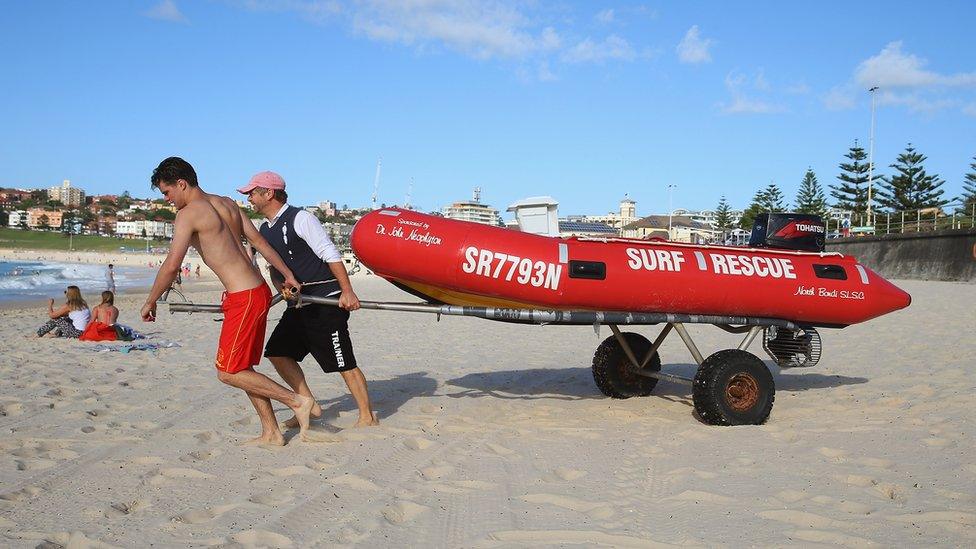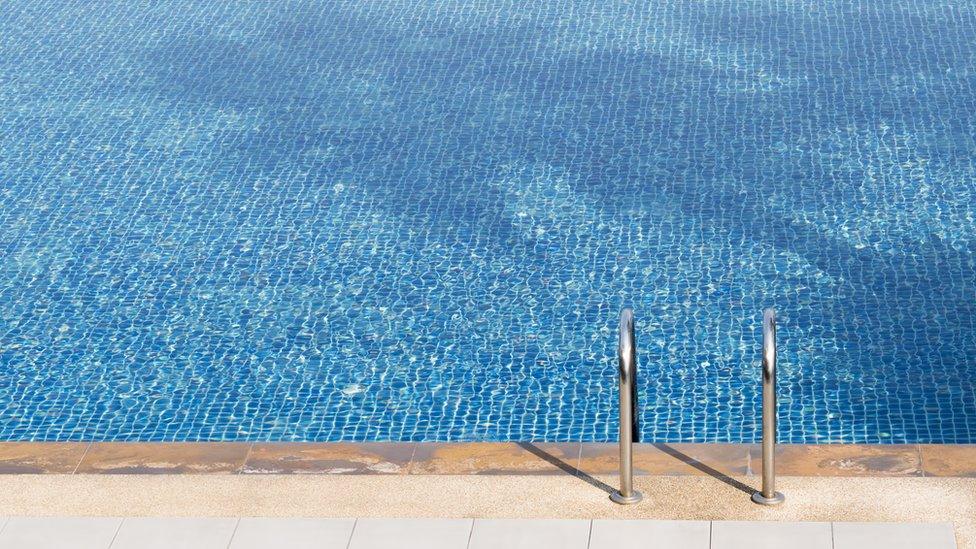Why has there been a spike in drownings in Australia?
- Published

The deaths have shocked New South Wales
Since Christmas Day, the Australian state of New South Wales (NSW) has endured a devastating 17 deaths by drowning.
The tragedies have hit seemingly everywhere, from popular Sydney beaches to remote inland waterholes and backyard swimming pools.
Three toddlers and a 14-year-old boy were among the victims. The others were all men.
The number of deaths - labelled "unprecedented" by authorities - has shocked NSW. Not even the state's roads, which claimed 248 more lives than drownings in 2015, have been as deadly since Christmas.
Surf Life Saving NSW fears more tragedies are to come.
"We could be looking at a bit of a horror toll for this December-January period," said spokeswoman Donna Wishart.
Debate over responsibility
NSW Emergency Services Minister David Elliott said although the state's "heart has broken" over the deaths, people must take responsibility for their own safety.
"If you don't know that your pool fence is childproof, fix it. If you don't know that a river has been running a current underneath it, don't go into it. If you don't know that a surf is safe, don't enter the surf," he told a press conference on Tuesday.

Timeline of deaths since Christmas Day:
25 December
Sujan Adhikari, 27, drowns at a lagoon in Royal National Park, in Sydney's south
26 December
Charli Manago, 23 months old, dies six days after being pulled from a Sydney pool alongside her twin brother
Geoffrey Blackadder, 60, drowns trying to save young relatives from a rip in Wooli Beach, in the state's north
Weibin Duan, 56, dies at a beach in Kioloa, in the NSW south
Sujan Sharma, 27, is killed while swimming near a picnic ground south of Sydney
27 December
Mohamed Amine Hamza, 25, drowns while swimming with friends at Greendale, in Sydney's west
A man, 83, drowns in an ocean pool on the state's central coast
28 December
A man, 64, dies at a beach at Byron Bay, in the state's north
29 December
Robbi Manago dies three days after his twin sister, Charli
30 December
Adnan Khan-Alfridi, 27, dies in a popular waterhole in Sydney's south
Peter Abd-El-Kaddous, 42, is found dead in a waterway in Wagga, west of Canberra
Tui Gallaher, 14, is found dead after going missing at Maroubra, a popular Sydney beach
A man, 46, dies at Yamba on the state's north coast
1 January
A two-year-old girl dies after being pulled from a pool in in Sydney's southwest
A man, 44, drowns while swimming in a lake in the Snowy Mountains, in the state's south
2 January
Richard Gee, an 83-year-old retired judge who once survived a bombing, external, dies in his pool in Sydney's north
4 January
A man, 80, is found dead in a creek at Shoalhaven, in the state's south
Two more deaths initially attributed to drowning were later found to have been caused by medical conditions.

Mr Elliott said the government had already allocated A$11m (£6.5m; $7.9m) towards improving water safety - including A$6m for designated "black spots".
"If there was a silver bullet, we would do it. But this is not something that can be easily fixed by changing the law," he said.
He said there was "no real consistency" among the deaths, except that a high proportion were male.
Inland deaths 'spike'
Ms Wishart, from Surf Life Saving NSW, said recent warm weather had contributed to the rise in deaths, with more people turning to water to cool off.
She said the frequency of beach tragedies was similar to last year, but more deaths were occurring in inland waterways and pools.
"That's definitely where the spike has been," Ms Wishart told the BBC.
"They're actually sometimes even more dangerous than the beach and the surf. You just don't know what's under the water. There's fast-moving currents. There's generally no water safety services there, no lifeguards on patrol."
Overseas victims 'over-represented'
At least two of the victims were reported not to be strong swimmers. Ms Wishart said recent migrants and visitors from overseas were over-represented in the tragedies.
"They're definitely getting into trouble on a regular basis," she said.
Justin Scarr, from the Royal Life Saving Society, said he was "deeply concerned" about the deaths of two international students, Sujan Adhikari and Sujan Sharma, in separate incidents.

Paramedics say too many children are left unsupervised near pools
"These people have come from countries where the drowning rate is 10, 15, 20 times higher than Australia," Mr Scarr told Australia's public broadcaster ABC.
"We've really got to do a better job of getting water safety messages, education skills and messages to people so that they can enjoy our waterways and not get themselves in trouble."
Alcohol often a factor
A report last week found that 40% of the 770 people who drowned in Australia's inland waterways in the past decade had alcohol in their system, according to the Sydney Morning Herald, external.
Nearly 83% of those victims were male, noted the research, which will be published in the Accident Analysis and Prevention journal.
Mr Scarr told the ABC men were more likely than women to swim after drinking alcohol and engage in "risk-taking behaviour".
"Any sort of water activity with alcohol is really heading for disaster," he said.
Calls for action
The tragedies have prompted calls for new safety measures, including mandatory school swimming lessons and even random breath tests for swimmers.
Royal Life Saving NSW said about half of children were leaving primary school without sufficient swimming skills - well up on a decade ago.
Leisa Hart, the YMCA chief for NSW, called on the government to offer rebates on swimming lessons, which were often expensive.
"We simply can't waste any more time debating whether this issue deserves a piece of the government funding pie," she wrote in the Sydney Morning Herald, external on Wednesday.
Ambulance NSW Inspector John Brotherhood said parents needed to keep a constant eye on children around water.
"In almost every case I've attended, it's been the same story, the pool gates haven't been fixed; the parents have been distracted or the kids have wandered out and got into trouble," he said.
"Nobody intends for these tragedies to happen, but paramedics sadly see time and again they do."
Reporting by the BBC's Jay Savage